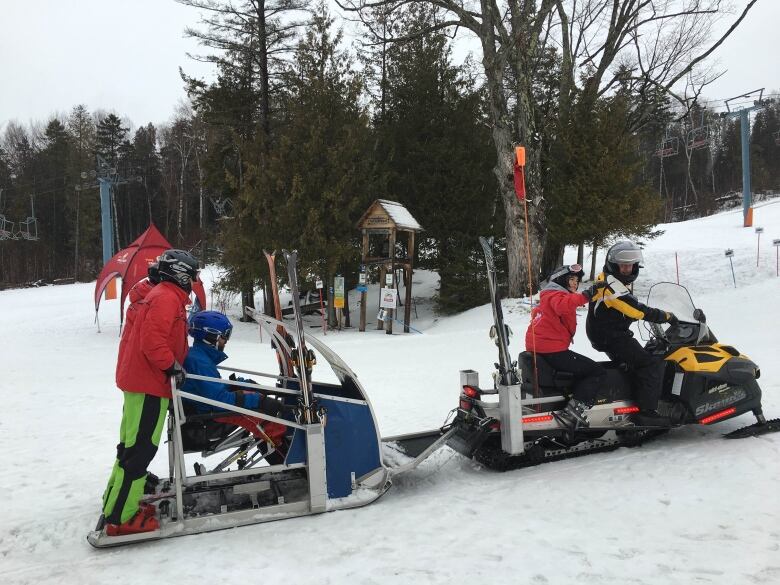Skiing for all: Adaptive Sports Foundation helps people overcome disabilities
We all love the speed, we all love the freedom, we all love the fresh air says participant

Alain Legault remembers the first time he saw a disabled person skiing using adapted gear.
An avid skier, he says he didn't give it much thought.
Now, it's a moment he recalls easily.
- Poley Mountain offers better access to skiers with disabilities
- Sit skier looks to boost sport's coverage, funding
These days, it's Legault who uses adaptive gear to hit the slopes five years after a stroke left him completely paralyzed on his left side.
"I woke up one day and half of my body was gone," he says. "I made myself a promise after the stroke that I would ski again some day."
Thanks to theAdaptive Sports Foundation, Legaultand many others are able to ski despite disability at Owl`s Head ski resort.
For 22 years, the foundation has provided adaptive equipment and a team of dedicated volunteers for 8 weeks every winter.
For Legault, that means using a ski glider,which looks like a stabilizing walker with skis attached,to help him balance himself.
It also means skiing with volunteers who are ready to help should he need a hand.

Anyone can ski
When it comes to who the foundation will help, the sky's the limit.
"Over the years we've seen just about everything," says volunteer Fred Cuplinskas, "There's a lot of accidents bike accidents and car accidents where now they're paraplegic."
The program also assists people with diseases like Multiple Sclerosis, and other conditions where movement is limited or difficult.
Even if a person is a quadriplegic paralyzed from the neck down Cuplinskas says there's a way to get them on the hill.
"I call it a floating couch," he says, "It's on two skis, and we can bring someone down in it."
When someone first comes to ski with the foundation, they're assessed to see what adaptive gear will best work for them.
"Our goal is to have them ski as much as possible in a stand-up position. But if you are a paraplegic it's impossible, so then you have to look at other opportunities where they are in a sit-ski, where you are sitting down and skiing." says Cuplinskas.

Helping people adjust to skiing with adapted gear comes with its challenges, says volunteer Barbara Cartmel.
"Getting them adjusted into the equipment, getting them up the hill, making sure that they are not cold," she says.
"Some of them their extremities are working very well, we don't know if they're cold, so we have to keep checking and making sure that they have the proper clothing on."
Going strong after 22 years
The program was started by Peter Treacy, who lost his right leg in a car accident.
"He noticed that for someone who was an amputee it was very difficult to get out and do winter activities. So he started this program by getting one piece of equipment," explains Cuplinskas.
The foundation charges a fee topeople who come ski with them, but is staffed exclusively by a team of about 100 volunteers.
Cartmel saysvolunteers keep coming back year after year because of how it makes them feel.
"It's just so rewarding, it's amazing. It's nice to go home and think about what you've done for the day and you made somebody happy."
'It's the very same feeling'
Maxime Jaccotin lost the use of his legs in a car accident ten years ago.
For the last nine years, he's used a sit-ski to whiz down ski hills.
"One of the toughest things that is to do when you sit-ski is basically when you fall, to get back up on your skis. Which is usually the most important role of the person skiing with you, to help you get back up when you fall," he says.
Overall, Jaccotinsaysthe feeling of skiing while sitting compared to standing is remarkably similar:
"As skiers, we all love the speed, we all love the freedom, we all love the fresh air, so to me, it represents the same thing as I guess it would be for you - the very same feeling."
As for Legault, he saysbringing skiing back into his life is "a gift."
"Just being back on the slope in the outside with the fresh air! Even if with my stroke I went from skiing black diamonds back to the bunny hill. So we're starting at zero again... but the only way to go is up!"
An avid skier once again, he sayshe's planning a trip to Whistler in the next three years.












_(720p).jpg)


 OFFICIAL HD MUSIC VIDEO.jpg)
.jpg)



























































































